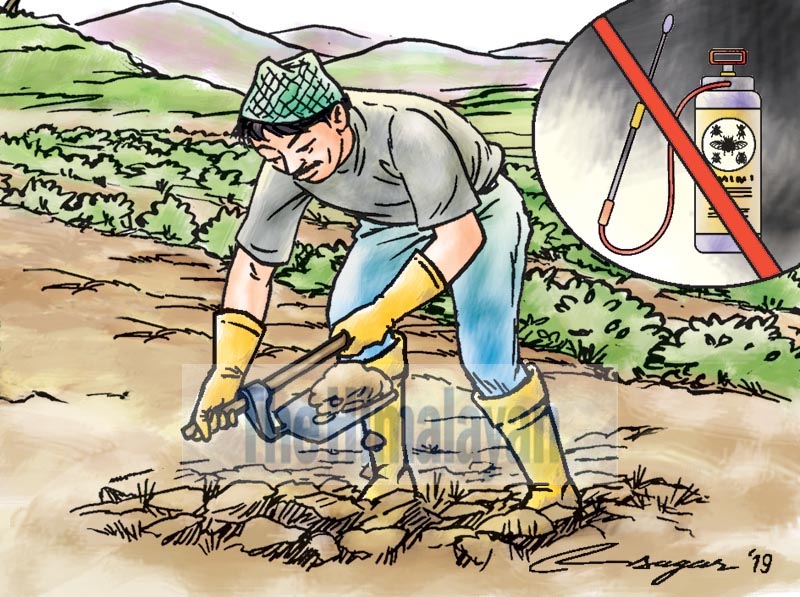Good agricultural practices: The future of farming
The EU is a lucrative market for Nepali tea, coffee and cardamom. Its strict regulations may affect the marketing of these products unless good agricultural practices are followed by the producers
With the increasing per capita income, consumers are becoming more and more conscious about their health. Production of safe food is not only important for consumer’s health but also for a sustainable environment and a healthy working condition for those producing the agricultural produce. Often, while talking about safe food production, the health of the farmer is not taken into account. The workers who spray pesticides are the most vulnerable to its impact. Due to lack of awareness and knowledge about safe and hygienic farming practices, a greater number of workers are found not using personal protective equipment while spraying pesticide. It is necessary for the producers and traders to adopt good agricultural practices (GAP) and good manufacturing practices (GMP) to maintain a healthy food supply chain.
GAP is defined as a “collection of principles to apply for on-farm production and post-production processes, resulting in safe and healthy food and non-food agricultural products, while taking into account economic, social and environmental sustainability.”
Following the publication of the book Silent Spring, authored by Rachel Carson in 1962, there was increased awareness of the impact of chemical insecticide on human health. And during the 1970s, agricultural production systems like organic agriculture and precision farming were considered as alternatives to conventional agricultural production in order to ensure the safety of consumer health and sustainability in agriculture. The outbreak of food-borne disease in the US during the 1990s gave rise to the concept of GAP and GMP. After 1997, good agricultural practices, which consider monitoring from production to consumption, have been practised worldwide.
The fundamental of good agricultural practices is the integration of the application of new production systems, such as Integrated Pest Management (IPM), Integrated Crop Management (ICM) and Integrated Nutrient Management (INM) for the commercial production of agricultural products.
The enforcement of GAP is more relevant today with the rampant use of pesticides and chemical fertilisers to boost production. GAP ensures safe crop production, facilitates regional trade and ensures acceptability of fruits and vegetables in the global market. It helps to produce quality goods with higher yield that comply with the standards of national and international regulations. Currently, exporters of agriculture products have been facing various hassles due to quality concerns being raised by the importing countries. Many importing countries as well as domestic buyers require producers to implement GAP to ensure the quality and safety of their produce.
Several studies have shown that the implementation of GAP encourages the promotion of optimum use of resources, such as pesticides, fertilisers and water. The social dimension of GAP helps to protect the health of agricultural workers from improper use of chemicals and pesticides while ensuring decent wages to them.
FAO has given four modules of GAP, which include: Food Safety Module, Environment Management Module, Produce Quality Module, Workers Health Safety and Welfare Module, and General Requirement Module. The first four modules are stand-alone modules and may be implemented depending upon the objective to be met. However, the general requirement module must be met by the farm in addition to any of the four modules.
Nepal endorsed Nepal Good Agriculture Practices Implementation Directive in October 2018 based on the Agriculture Development Strategy (ADS), Nepal Agro Business Policy, 2016 and GAP prepared for SAARC countries by FAO. Any farm that wants to receive recognition or certification of GAP must apply for it at the respective accreditation institute, which in Nepal is the Department of Food and Quality Control (DFQC), and then abide by the rules as mentioned in the Nepal GAP Implementation Directive. Upon successful accomplishment of the standards set by the certification body, the farm receives a certification of GAP.
Nepal is a member of the World Trade Organization (WTO). It has to follow the code of conduct of WTO while exporting goods. There is that bitter experience of Nepali tea and honey being rejected by the European Union due to the presence of high pesticide residue in them. Frequently, trucks carrying Nepali products are made to wait at the Indian border on suspicion that they contain pesticide residue above the maximum level allowed.
Lack of certification of Nepalese agricultural products has been causing post-harvest loss as well as it has been diminishing the consumer’s trust on our products. The European Union has declared that it will allow the import of only certified products into the European market from the middle of 2017. The EU is one of the lucrative markets for Nepali tea, coffee and cardamom. Strict regulations of the European Union may affect the marketing of Nepali products unless good agricultural practices are followed by the producers.
For the promotion of GAP, the government needs to organise massive training for the farmers; especially those who are involved in commercial farming. Similarly, the establishment of a certification body at the local level is of prime importance for encouraging the farmers to adopt good agricultural practices.






